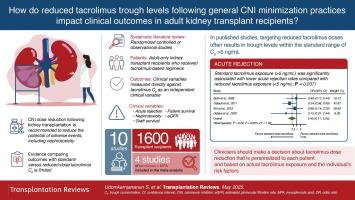The impact of standard- versus reduced-dose tacrolimus exposure on clinical outcomes in adult kidney transplant recipients: A systematic review and meta-analysis
IF 3.6
2区 医学
Q2 IMMUNOLOGY
引用次数: 0
Abstract
Concerns around calcineurin inhibitor–induced nephrotoxicity after kidney transplantation have led to dose-reduction practices. However, “reduced dose” remains poorly defined, and evidence comparing outcomes for standard- versus reduced-dose tacrolimus trough concentration (C0) above 5 ng/mL is limited. We searched multiple electronic databases (Jan 1, 2000-June 30, 2024) for randomized controlled or observational studies that reported clinical outcomes (acute rejection, nephrotoxicity, graft survival, patient survival, and estimated glomerular filtration rate) directly against tacrolimus C0 as an independent clinical variable in adult kidney transplant recipients who received tacrolimus. Ten publications were included. No eligible study of tacrolimus with mammalian target of rapamycin inhibitors was identified, so results focused on patients treated with tacrolimus plus mycophenolic acid. Four randomized controlled trials with similar immunosuppression regimens were included in the meta-analysis to compare the impact of standard- versus reduced-dose tacrolimus exposure (per study definition) on C0 and clinical outcomes. Standard-dose tacrolimus exposure was associated with significantly lower acute rejection rates versus reduced-dose exposure (odds ratio, 0.4 [95 % confidence interval: 0.17, 0.95]; P = 0.037). There were no significant differences between groups in graft loss or patient survival. An overlap in drug concentrations between standard- and reduced-dose tacrolimus C0 suggests that reduced-dose tacrolimus regimens can often result in an exposure that falls within the standard range (i.e., 5–10 ng/mL). Clinicians should consider the precise tacrolimus dose ranges reported in publications and optimize tacrolimus concentration levels for individual patients, potentially contradicting some recommendations for calcineurin inhibitor minimization.

标准剂量与减少剂量他克莫司暴露对成人肾移植受者临床结果的影响:系统回顾和荟萃分析
对肾移植后钙调磷酸酶抑制剂引起的肾毒性的担忧导致了剂量减少的做法。然而,“减少剂量”的定义仍然不明确,比较标准剂量与减少剂量他克莫司谷浓度(C0)高于5 ng/mL的结果的证据有限。我们检索了多个电子数据库(2000年1月1日至2024年6月30日),以获取随机对照或观察性研究,这些研究报告了他克莫司C0作为成人肾移植受者接受他克莫司的独立临床变量的临床结果(急性排斥反应、肾毒性、移植物存活率、患者存活率和估计肾小球滤过率)。其中包括10份出版物。没有合适的研究确定他克莫司与哺乳动物雷帕霉素抑制剂靶点,所以结果集中在他克莫司加霉酚酸治疗的患者。荟萃分析包括四项具有相似免疫抑制方案的随机对照试验,以比较标准剂量与减少剂量他克莫司暴露(每个研究定义)对C0和临床结果的影响。标准剂量他克莫司暴露与低剂量暴露相比,急性排斥反应发生率显著降低(优势比为0.4[95%可信区间:0.17,0.95];P = 0.037)。两组间移植物丢失和患者存活率无显著差异。标准剂量和减剂量他克莫司C0之间药物浓度的重叠表明,减剂量他克莫司方案通常可导致暴露在标准范围内(即5-10纳克/毫升)。临床医生应该考虑出版物中报道的精确的他克莫司剂量范围,并为个体患者优化他克莫司浓度水平,这可能与一些钙调磷酸酶抑制剂最小化的建议相矛盾。
本文章由计算机程序翻译,如有差异,请以英文原文为准。
求助全文
约1分钟内获得全文
求助全文
来源期刊

Transplantation Reviews
IMMUNOLOGY-TRANSPLANTATION
CiteScore
7.50
自引率
2.50%
发文量
40
审稿时长
29 days
期刊介绍:
Transplantation Reviews contains state-of-the-art review articles on both clinical and experimental transplantation. The journal features invited articles by authorities in immunology, transplantation medicine and surgery.
 求助内容:
求助内容: 应助结果提醒方式:
应助结果提醒方式:


